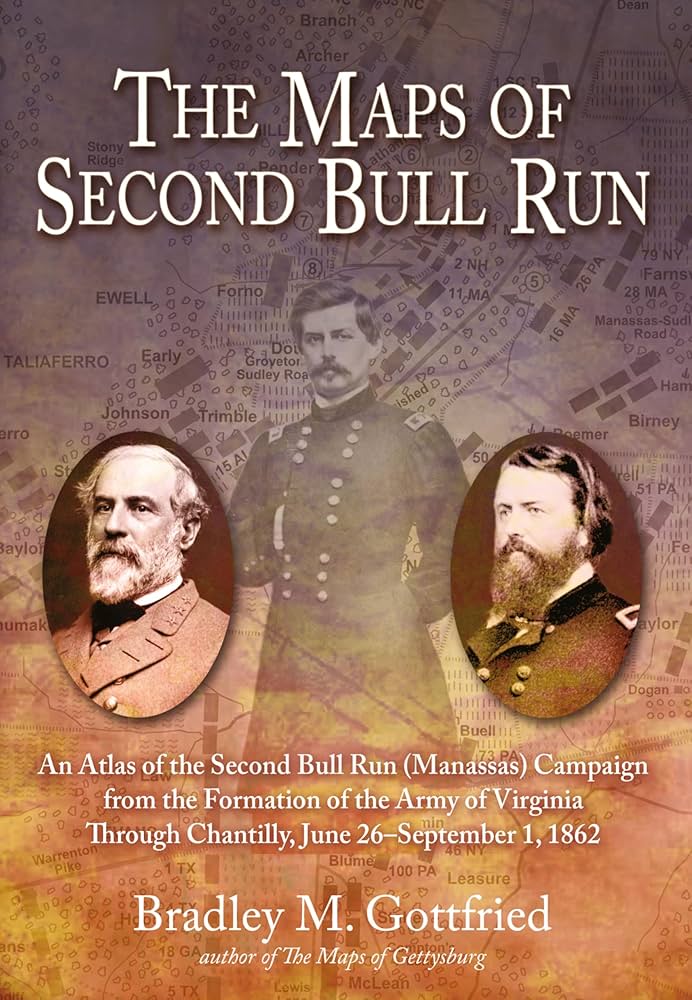Book Review The Maps of Second Bull Run: An Atlas of the Second Bull Run (Manassas) Campaign from the Formation of the Army of Virginia through Chantilly, June 26-September 1, 1862

 The Maps of Second Bull Run: An Atlas of the Second Bull Run (Manassas) Campaign from the Formation of the Army of Virginia through Chantilly, June 26-September 1, 1862. By Bradley M. Gottfried. El Dorado Hills, CA: Savas Beatie, 2024. Hardcover, 320 pp. $39.95.
The Maps of Second Bull Run: An Atlas of the Second Bull Run (Manassas) Campaign from the Formation of the Army of Virginia through Chantilly, June 26-September 1, 1862. By Bradley M. Gottfried. El Dorado Hills, CA: Savas Beatie, 2024. Hardcover, 320 pp. $39.95.
Reviewed by Scott C. Patchan
Way back in 1989, I lived in Salem, Virginia, while my wife finished school at Roanoke College. Being somewhat off the beaten path of Civil War history, I quickly learned that the college Library had in its collection a complete copy of the Official Records of the War of the Rebellion. At the time the library occupied the old Roanoke County Courthouse, I spent many evening hours there reading through the reports of various battles and campaigns. While there one evening, I discovered John Hennessy’s Second Manassas Battlefield Map Study which was originally published by the U.S. Government. It was an amazing document containing sixteen poster-sized maps with full documentation in the form of primary source material from the soldiers of Second Bull Run. It was an incredible document that I purchased a few years later when it became available in book form by H.E. Howard as part of the Virginia Civil War Battles and Leaders Series. Having moved to Northern Virginia in 1991, I utilized these maps, traipsing over the Manassas Battlefield for more than thirty years and had to eventually obtain a replacement set due to the wear and tear from field usage.
Fast-forward 34 years to 2025, and Bradley Gottfried delivers a tour de force map study on the Second Bull Run Campaign published by Savas Beattie LLC. The book contains well over 100 highly detailed, full-color maps. Gottfried starts readers off on June 26, 1862, the day Maj. Gen. John Pope assumed command of the newly created Army of Virginia offering a series of theater-level maps showing the positions and movements of all Union and Confederate forces operating in the Old Dominion at that time. These maps display the movements of Pope’s and Maj. Gen. Thomas J. “Stonewall” Jackson’s forces in the Virginia Piedmont culminating with the epic showdown at the Battle of Cedar Mountain on August 9. At this point, Gottfried provides nineteen maps detailing the ebb and flow of combat at Cedar Mountain.
Next the book provides us with a highly detailed mapping of the movements of the armies between Cedar Mountain and Second Bull Run. These maps display the movements along and between the Rapidan and Rappahannock Rivers, Jackson’s epic flank march, and the associated engagements as well as the arrival of reinforcements from the Army of the Potomac and Generals Robert E. Lee and James Longstreet.
The book then moves on to Thoroughfare Gap and Brawner farm, bringing great detail to these pivotal engagements that set up the Second Battle of Bull Run. Gottfried covers the fighting throughout August 29 and 30 at Manassas Battlefield, wading into the often-confusing action and bringing clarity to the reader. The tactical action of Pope’s assaults against Jackson at the Unfinished Railroad Cut, Porter’s Attack, and Longstreet’s counterattack are shown in detailed iterations as well as the controversial bigger picture operations of Maj. Gen. Fitz John Porter and Longstreet on the southern fringes of the battle. Each map includes a page of historical narrative explaining the associated action to the reader. These accounts are well written and at an appropriate level of detail to ensure that the reader understands the action on the map. While I had some quibbles with some of the minutiae in the interpretation here and there, the scope and magnitude of this intricately focused study will leave the reader, and perhaps more especially the boots on the ground battlefield stomper, in awe. It is an invaluable tool for anyone interested the Second Bull Run Campaign.
Gottried has certainly continued in his fine tradition of maps of the Eastern Theater Campaigns, and one can only hope that he continues with volumes on Chancellorsville and others yet unexplored.
Scott C. Patchan, a veteran Civil War battlefield guide and historian, is the author of Second Manassas: Longstreet’s Attack and the Struggle for Chinn Ridge (2011), Shenandoah Summer: The 1864 Valley Campaign (2009), and The Forgotten Fury: The Battle of Piedmont, Virginia (1996). He also served as a research consultant and contributing writer for Time-Life’s Voices of the Civil War: Shenandoah, 1864 (1998). Patchan has twice served as president of the Bull Run Civil War Round Table and is a much sought after tour guide for both Revolutionary and Civil War battlefields and historic sites. He resides in Spotsylvania, Virginia.
Love to see a side by side map of where Lee/Jackson were, and where Pope thought they were at that time!
I love maps! A graphic display is vital to readers’ understanding of a battle.
Scott
Thank you for the review. You talked me into buying it as a guide to a fascinating campaign. Thank you also for the shout out to Roanoke College. I graduated in 1983 and I’m guessing that 1989 was when the Fintel Library was being renovated.
Great Review. I have every one of the books in the Savas Beatie Military Atlas Series and use them every time I read about the battles they cover. The maps and the accompanying text are invaluable. Can never have too many maps. They make studying, following, and understanding the battles so much easier. You know the old adage – a picture is worth a thousand words. Hopefully new atlases will continue to be published.